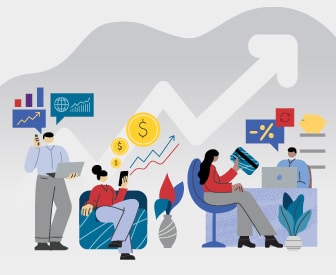Machine learning is an area of computer science that uses large-scale data analytics to create predictive and dynamic models. In essence, you feed the right data to computers with the right algorithms and they have the ability to learn — automatically, on their own. These algorithms iteratively improve over time. That’s the “learning” part of machine learning that allows computers to find hidden insights without being explicitly programmed where to look for them.
The exceptionally large data sets used in machine learning make it possible for computers to recognize both anomalies and patterns lurking within the information, yielding faster and more accurate data-driven decisions.
The process of crunching numbers is made more efficient, reliable and cost effective thanks to major advancements in machine learning. This up and coming technology is driving innovation in every sector — but particularly in banking — and it will only continue to grow in popularity.
Some familiar real-world examples of machine learning include online recommendations in the online retail industry (i.e. Amazon and Walmart), allowing retailers to offer customers personalized recommendations based on previous activity and purchases. Apple uses machine learning in their voice recognition system, Siri, to imitate human interactions. Facebook uses the technology to tag individuals in photos. Google Maps analyzes the speed of traffic on roadways with location data from smartphones. And nearly every major tech company that serves an ad online uses some sort of machine learning to determine which ads to show to whom. In the 2016 U.S. Presidential election, some ads were actually created using machine learning algorithms that figured out which buzzwords, colors, images and buttons got clicked the most.
This is why companies are pouring a huge amount of resources into the technology. Mountains of raw data is now being collected on a daily basis and processed using sophisticated and powerful data analytics tools and machine learning tools to tease out useful insights.
“Traditionally, predictive modelling techniques have mostly been used in credit businesses for scoring purposes,” says Theunis Jansen Van Rensburg, Head of Commercial Analytics at Wonga. “Today’s reality is different – if you’ve got the data you can employ predictive models to optimize any part of your business.”
The good news? The banking industry has access to sprawling archives of historical records and data, which is perfectly suited for artificial intelligence and machine learning applications.
In the banking industry, machine learning can play an integral role in many stages, from approving loans and assessing risks to managing assets. So far, it has mainly been used for determining the lending risks of customers based on their income and credit history, but there is much more than can still be done. Here are a few machine learning applications that have the ability to further improve the service experience in the banking industry.

Navigating the Role of AI in Financial Institutions
83% of FI leaders agree investing in AI is essential for 2024 but how you leverage AI is instrumental in success and meeting customer expectations.
Read More about Navigating the Role of AI in Financial Institutions

Send the Right Offers to the Right Consumers
Achieve a better return on your marketing investment. Leverage behavioral data and analytics to target the right customers with the best possible offers.
Read More about Send the Right Offers to the Right Consumers
1. Improved Marketing and Cross-Selling
Machine learning can be used as a powerful tool for developing more detailed insights into both customers and prospects. Drawing on a wide range of both internal- and external data, marketers are given much more to work with than they have ever had in the past. Customers can be more accurately segmented according to their profiles and probable needs, offering new opportunities for up-selling and cross-selling.
2. Automating Chatbot Conversations
Machine learning can also be used to boost customer service within the banking industry, with the rise of chatbots and conversational interfaces. These chat bots are virtual assistants that are built with robust natural language processing engines combined with specific customer interactions. Allowing customers to get information quickly and easily improves service levels and offers a unique advantage over other companies that require customers to pick up the phone or send an email. At the same time, these virtual assistants save valuable workforce time, allowing businesses to save money and have their teams focus on other aspects of the business. This kind of chat experience is not yet the norm in the banking industry but is expected to grow in popularity.
3. Predicting Reasons for Customers’ Calls
Call reason predictions are yet another way that machine learning can make a huge impact on the banking industry. The number of customer calls being made on a daily basis is ever growing, and as a result the number of calls being routed to incorrect departments is an increasing issue. Customers are also experiencing longer wait times than ever, leading to an increase in call drop-offs and unsatisfied customers. Machine learning can help by predicting the reason for a customers’ call based on the time of day the call is being made and other variables. This allows the call to be routed directly to the correct department for that specific customers’ needs.
4. Detecting Fraud
With the combination of computing power, internet and an increasing amount of valuable data being stored online, the data security risk is higher than ever. In the past, financial fraud detection systems were heavily dependent on complex and robust rules. Whilst more modern fraud detection goes further than just following a checklist of risk factors, it can actively learn and calibrate to detect new potential security threats. Machine learning systems can detect anomalies in online activities and behaviors and flag them for security teams to investigate further.
5. Improving Collections
At present, some customers experience from credit companies is being negatively impacted by being contacted by collections teams unnecessarily. Machine learning can help this issue by predicting which borrowers that go into arrears can resolve their issues without contact and support from the credit company. Not only will this improve the customer experience, it will also have an impact on reducing the cost and time of collections teams.







